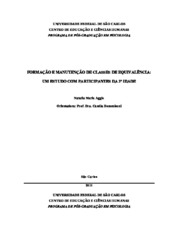Formação e manutenção de classes de equivalência: um estudo com participantes da 3ª idade
Resumo
The paradigm of stimulus equivalence has been widely studied, with different populations. Several studies have investigated the variables that can influence the formation and maintenance of equivalent stimulus classes. Regarding to formation, some authors point that the structure of train CaN and the arrangement simple to complex can facilitate this formation. Regarding to maintenance, some authors propose, for example, that classes with higher number of stimuli are more stable and are easier to be remembered over time. Despite the diversity of populations studied with procedures derived from the paradigm of stimulus equivalence, there is still a lack of studies with the elderly population. In order to enlarge the knowledge about the generality of the phenomenon of formation and maintenance of equivalent classes stimulus, this study proposed to investigate the formation of equivalent classes of different sizes and the role of this size in the maintenance of the classes with participants between 60 and 75 years. The procedure of matching-to-sample was used to teach three classes of equivalent stimuli composed of three or six stimulus (Condition 1 and Condition 2). The experimental procedure consisted of a training phase of baseline relations and testing of emerging relations, and six weeks after the first phase, a test was done with the emerging and learned relations to check the maintenance of classes formed. All participants showed the emergence of classes of equivalent stimulus. Three participants showed immediate emergency and five delayed emergency. All the participants who went through Condition 1 had percentages of correct responses below 90% in the test done after six weeks, while participants who underwent Condition 2 had hit percentages above 90%. Since most participants from Condition 2 showed accuracy right in the beginning of the test, it was not possible to evaluate the recovery of the relations throughout the test made six weeks later. This performance showed that the size of the class may be a relevant variant that influences the stability of the class over time, since the participants in the condition that trained with larger classes had better results on this test. This paper presents contributions to the studies of stimulus equivalence, since studies with this population are rare, and to understanding the factors involved in the formation and maintenance of stimulus equivalence.
